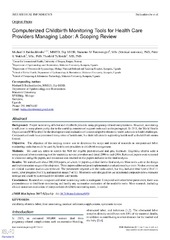| dc.contributor.author | Balikuddembe, Michael | en_US |
| dc.contributor.author | Tumwesigye, Nazarius M. | en_US |
| dc.contributor.author | Wakholi, Peter Khisa | en_US |
| dc.contributor.author | Tylleskär, Thorkild | en_US |
| dc.date.accessioned | 2018-09-05T09:07:48Z | |
| dc.date.available | 2018-09-05T09:07:48Z | |
| dc.date.issued | 2017 | |
| dc.Published | Balikuddembe, Tumwesigye, Wakholi PK, Tylleskär T. Computerized Childbirth Monitoring Tools for Health Care Providers Managing Labor: A Scoping Review. JMIR Medical Informatics. 2017;5(2):e14 | eng |
| dc.identifier.issn | 2291-9694 | |
| dc.identifier.uri | https://hdl.handle.net/1956/18388 | |
| dc.description.abstract | Background: Proper monitoring of labor and childbirth prevents many pregnancy-related complications. However, monitoring is still poor in many places partly due to the usability concerns of support tools such as the partograph. In 2011, the World Health Organization (WHO) called for the development and evaluation of context-adaptable electronic health solutions to health challenges. Computerized tools have penetrated many areas of health care, but their influence in supporting health staff with childbirth seems limited. Objective: The objective of this scoping review was to determine the scope and trends of research on computerized labor monitoring tools that could be used by health care providers in childbirth management. Methods: We used key terms to search the Web for eligible peer-reviewed and gray literature. Eligibility criteria were a computerized labor monitoring tool for maternity service providers and dated 2006 to mid-2016. Retrieved papers were screened to eliminate ineligible papers, and consensus was reached on the papers included in the final analysis. Results: We started with about 380,000 papers, of which 14 papers qualified for the final analysis. Most tools were at the design and implementation stages of development. Three papers addressed post-implementation evaluations of two tools. No documentation on clinical outcome studies was retrieved. The parameters targeted with the tools varied, but they included fetal heart (10 of 11 tools), labor progress (8 of 11), and maternal status (7 of 11). Most tools were designed for use in personal computers in low-resource settings and could be customized for different user needs. Conclusions: Research on computerized labor monitoring tools is inadequate. Compared with other labor parameters, there was preponderance to fetal heart monitoring and hardly any summative evaluation of the available tools. More research, including clinical outcomes evaluation of computerized childbirth monitoring tools, is needed. | en_US |
| dc.language.iso | eng | eng |
| dc.publisher | JMIR | eng |
| dc.rights | Attribution CC BY | eng |
| dc.rights.uri | http://creativecommons.org/licenses/by/4.0 | eng |
| dc.subject | childbirth | eng |
| dc.subject | obstetric labor | eng |
| dc.subject | fetal monitoring | eng |
| dc.subject | medical informatics applications | eng |
| dc.subject | systematic review | eng |
| dc.title | Computerized Childbirth Monitoring Tools for Health Care Providers Managing Labor: A Scoping Review | en_US |
| dc.type | Peer reviewed | |
| dc.type | Journal article | |
| dc.date.updated | 2018-03-06T08:57:55Z | |
| dc.description.version | publishedVersion | en_US |
| dc.rights.holder | Copyright 2017 The Author(s) | |
| dc.identifier.doi | https://doi.org/10.2196/medinform.6959 | |
| dc.identifier.cristin | 1570729 | |
| dc.source.journal | JMIR Medical Informatics | |

